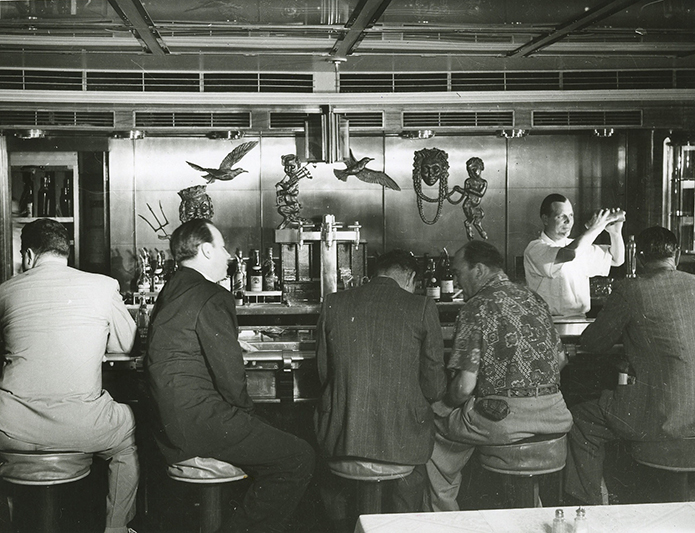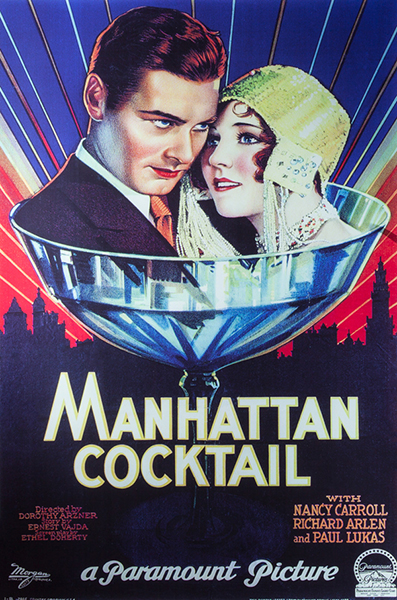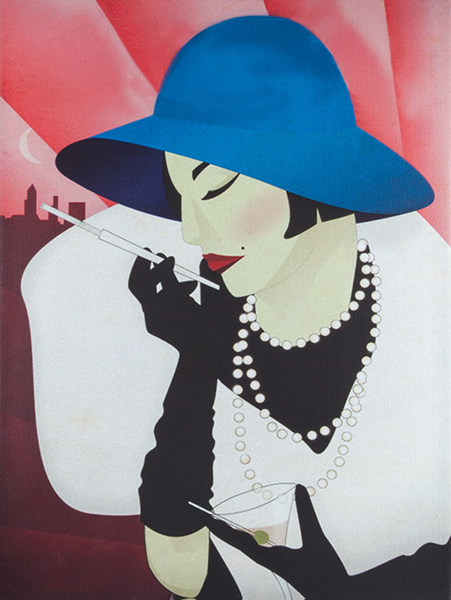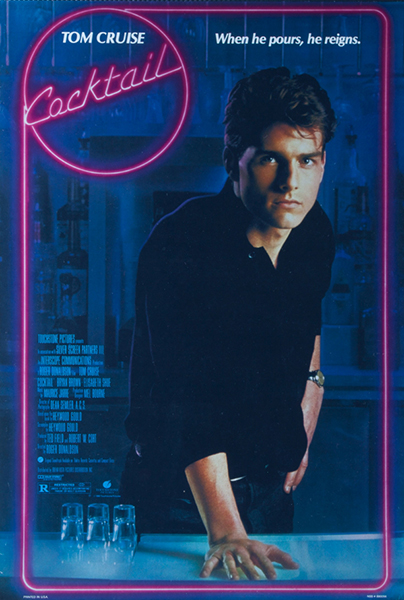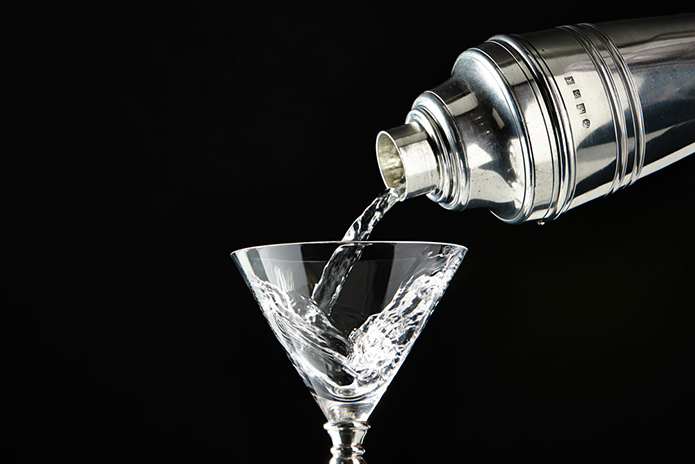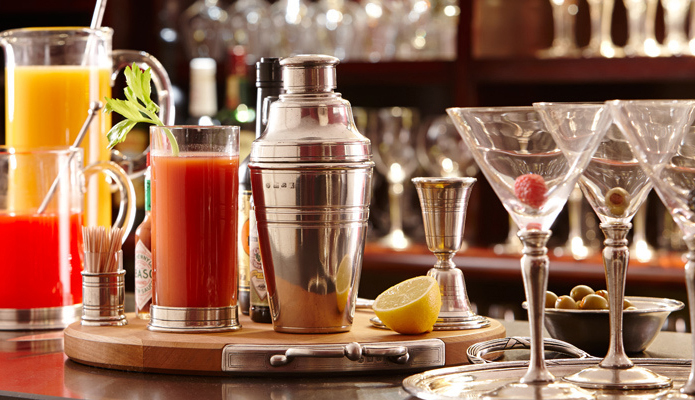
Image courtesy of Cosi Tabellini UK.
Are you a purist; scientifically measuring and decanting, carefully studying the recipe? Or are you more relaxed; guesstimating a slug and hoping for the best? Or do you pretend to be ‘Bond, James Bond; stipulating the well-documented procedure behind your chosen tipple? Whichever you are, few can resist the old-fashioned charm of a stylish cocktail shaker, complete with measuring jigger and iconic martini glass, taking you back to the silver screen glamour of early 20th Century Hollywood. There is a surprisingly long, hazy (well we are talking cocktails here!) and intriguing history when it comes to cocktails, from fermenting jars of honey and spiced concoctions, to cock & bull tales and Cock Ales in 16th Century Britain. Either way, the evolution of the cocktail as an iconic part of our shared culture is a fascinating one. So, sit back, sip, and we’ll begin…
The origin of the term cocktail is disputed. There is almost a mythology associated with mixology, the art of mixing drinks, and the very origin of such concoctions can, without firm evidence, be the stuff of legend. Evidence for the mixing of drinks can be cited to many millennia ago; South Americans stored mixed liquids in primitive vessels, which would have led to fermentation and thus a mixed alcoholic drink; five thousand year old Mesopotamian earthenware was discovered from the banks of the Tigris containing traces of tartaric acid, honey, apple juice and barley, as often Egyptians mixed spices and other ingredients to hand with fermented drinks to make them more palatable, and Emperor Lucius Aurelius, in Roman times, was prescribed a mixed wine-based drink by his physician; the drink posca was originally a medicinal mixture used in ancient Greece which was very popular with the Roman army, and survived as late as the Byzantine period. The British Navy encouraged their sailors to drink grog in the 17th century, which was a mixture of rum and water, as a way of getting sailors to drink water. Grog was served by the British Navy well into the 20th Century. Punch, also popular amongst the British Navy by the end of the 17th Century, was a concoction of five ingredients (Panch means “five” in Hindi) – including liquor, citrus juice, tea (or other spice), water and sugar.
The origin of the term cocktail is disputed. There is almost a mythology associated with mixology, the art of mixing drinks, and the very origin of such concoctions can, without firm evidence, be the stuff of legend. Evidence for the mixing of drinks can be cited to many millennia ago; South Americans stored mixed liquids in primitive vessels, which would have led to fermentation and thus a mixed alcoholic drink; five thousand year old Mesopotamian earthenware was discovered from the banks of the Tigris containing traces of tartaric acid, honey, apple juice and barley, as often Egyptians mixed spices and other ingredients to hand with fermented drinks to make them more palatable, and Emperor Lucius Aurelius, in Roman times, was prescribed a mixed wine-based drink by his physician; the drink posca was originally a medicinal mixture used in ancient Greece which was very popular with the Roman army, and survived as late as the Byzantine period. The British Navy encouraged their sailors to drink grog in the 17th century, which was a mixture of rum and water, as a way of getting sailors to drink water. Grog was served by the British Navy well into the 20th Century. Punch, also popular amongst the British Navy by the end of the 17th Century, was a concoction of five ingredients (Panch means “five” in Hindi) – including liquor, citrus juice, tea (or other spice), water and sugar.
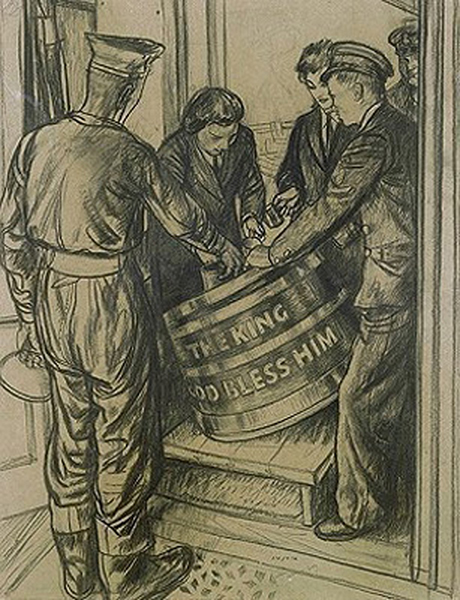
Illustration of Royal Navy grog rations being served on board ship. Image courtesy of Imperial War Museum, 1942.
The word cocktail, according to the Oxford English dictionary, lists the word originating in the US, and although commonly viewed as an iconically American invention, there are centuries-old British origins stretching back to 17th Century London. In the late 1600s, King William of Orange introduced a distillation tax as there was a huge grain surplus, resulting in thousands of gallons of grain spirit flooding the British market, leading to a rise in the production of grain-based spirits. Part of this new generation of spirit drinking were gin-based drinks with added medicinal bitters. These were often botanically-based tinctures and patent medicines sold by physicians and apothecaries as health-boosting drinks. There are a number of etymologies for the term cocktail, all deriving from the concept of ‘mixing’: a mixture of the last dregs – tailings – poured from all the barrels’ taps, known as ‘cocks’, hence the term ‘cock-tail’; American apothecaries served a mixture of brandy, sugar, water and bitters in an egg-cup; a cocquetier – shortened over time to ‘cocktay’…; mixing ale, large cock, sugar, raisins, mace and cloves and leave to steap (see recipe in Compleat Housewife, 1736) to form ‘cock-ale’; mixed-breed horses in Britain had their tails bobbed or ‘cocked’ to distinguish them – a ‘cock-tail’. As you can see, there is much conjecture as to the true origin of the term.
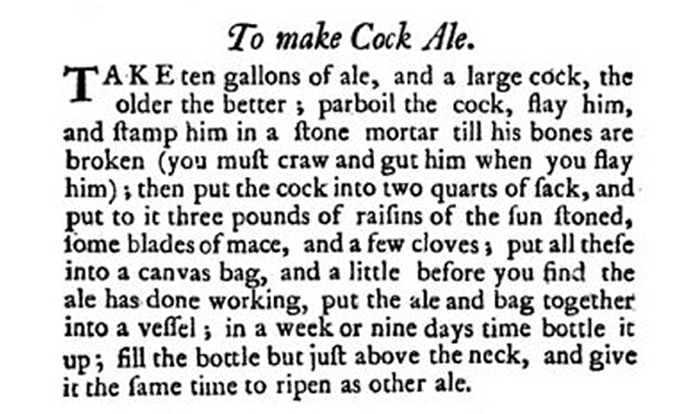
Recipe for Cock Ale from The Compleat Housewife or Accomplish’d Gentlewoman’s Companion, written by Eliza Smith, 1736.
The first recorded use of the word cocktail is found in London’s The Morning Post and Gazetteer, 1798, listing ‘cock-tail’ on a bar-tab in Axe & Gate Tavern, on the corner of Downing Street and Whitehall, patronised by politicians of the day, like William Pitt the Younger. The first recorded mention of the term in the United States is in The Farmer’s Cabinet, 1803, referring to a ‘lounger’ with an 11am hangover drinking a glass of cocktail as it was “excellent for the head”. Cocktails were officially defined in 1806 in The Balance and Columbian Repository as “a stimulating liquor composed of any kind of sugar, water and bitters, vulgarly called a bittered sling.” The first cocktail recipe recorded seems to be attributed to Capt J.E. Alexander in 1831, calling for either brandy, gin or rum in a 1:2 mix of spirit:water, along with bitters, sugar and nutmeg.
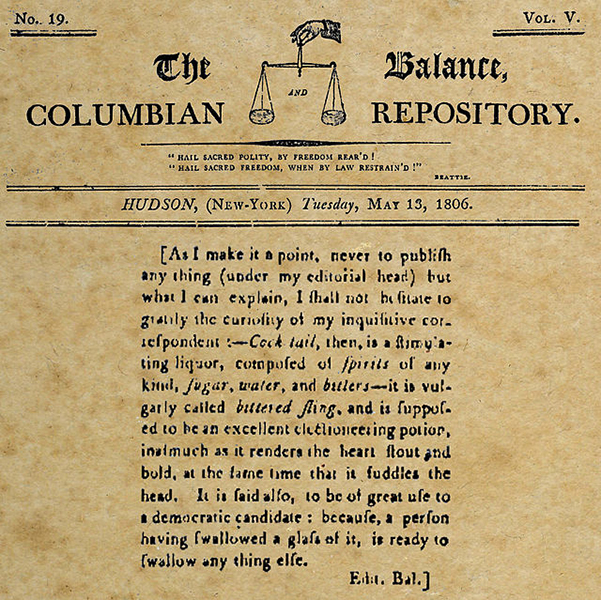
The first definition of a Cocktail by Harry Croswell in The Columbian Balance and Repository, 13 May, 1806. Image courtesy of Wikimedia Commons.
American Jerry Thomas produced a guide for mixology in the 1862 How to Mix Drinks or The Bon Vivant’s Companion thus promoting the ‘good life’ of a cocktail drinker. In amongst the numerous recipes for mixed Punches, Sours, Slings, Cobblers, and Toddies, there were 10 recipes for drinks referred to as “Cocktails”. A key ingredient which differentiated “cocktails” from the other drinks was the ingredient; bitters. Thomas has been cited as the father of modern bartending, but interestingly, he had worked in London before producing his book, thus must have been influenced by British drinking culture. In Britain, in 1869, William Terrington’s Cooling Cups and Dainty Drinks was published, outlining the traditional cocktail; Gin Cocktail – brandy or gin, ginger syrup, aromatic bitters and a splash of water. At some point around this time the cocktail shaker is thought to have been invented, adding the classic showmanship to cocktail making and shaking.
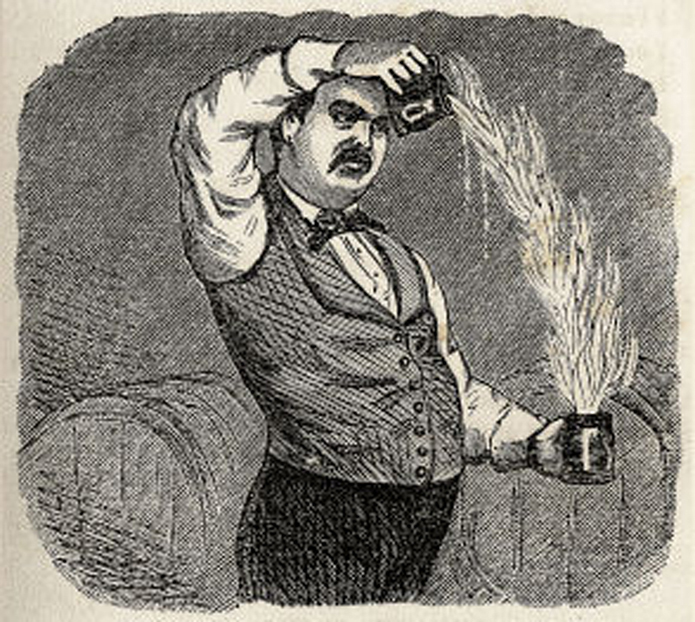
Jerry Thomas – author of the first book with cocktail recipes. Image courtesy of Wikimedia Commons/Museum of the American Cocktail.
By the late 19th Century cocktail had come to mean any mixed drink that contains one or more kinds of spirit and one or more mixers, such as soda or fruit juice. It was a Victorian idea to mix hard liquor with soft drink and fruit, which evolved over time to include herbs & spices, honey, milk and sugar. This takes us to the more recognisable and familiar image of Cocktail drinking we are all familiar with; the golden era of the Cocktail the early 20th Century. Cocktail parties became popular in the early part of the 20th Century in America where a whole etiquette built up around the cocktail party, with drinks served before a meal, and cocktail dresses and lounge suits were worn. It was the start of the golden age of cocktails, especially seen through the glamour of the Silver Screen, where stars smoked and sipped their cocktails.
Even during the period of prohibition in the US (1920–1933), when the consumption of alcohol was illegal, cocktails were still popular, commonly consumed in establishments known as ‘speakeasies’. The quality of spirits available at this time was extremely poor. There was a switch to gin as it didn’t require aging like other spirits and was therefore easier to produce illicitly, even in the bath. Flavourings such as fruit juice and honey masked the foul taste of these inferior spirits. Also, sweeter cocktails were easier to drink quickly, which was an extremely important factor, as during these times the venue could be raided at any moment. The very wide glasses themselves were thought to have been borne out of necessity – picture the wide mouth of a martini glass, easily tipped if the contents had to be ‘lost’ in a panic…

Orange County Sheriff’s deputies dumping illegal alcohol, Santa Ana, 1932. Image courtesy of Orange County Archives.
Around this time, affluent Americans, able to travel, began to visit London. ‘American’ bars, and subsequently ‘Cocktail’ bars emerged, especially during the Prohibition era, when many American barworkers came to London to continue their trade, and American tourists arrived thirsty for a legal drink. The best known and most enduring American bar in London was (and still is) at The Savoy. At the time the British bar-staff were developing countless new drinks, and many of the recipes crossed the Atlantic to the States, only to be reintroduced into Europe later as American drinks. The Savoy barman, Harry Craddock, had a similar Anglo-influenced past; a Brit, born in Gloucestershire, migrated to the US years before, and returned to Britain as a naturalised American with a huge catalogue of cocktail recipes, culminating in The Savoy Cocktail Book, 1930, which are still used all over the world today.
The popularity of the cocktail reached a climax in late 1930s America after the double stranglehold of both the Prohibition and the Great Depression ending. The golden age of the cocktail continued, with many Americans keen to relive the drama of Prohibition period invested in a cocktail shaker for the home. However, the onset of the Second World War curtailed any frivolous uses of metal, including the humble cocktail shaker, and a period of war-time austerity, post-war recovery and modernist realism in the 1950s put pay to the heady and frivolous days of the cocktail.

The energy crisis in the States of Oregon and Washington resulted in attempts at humour by businesses with outdoor signboards, 1973. Image courtesy of US National Archives, Still Pictures Section.
Cocktails became less-and-less popular through the 1960s and early 1970s, yet started to make a comeback in the mid-late 1970s. 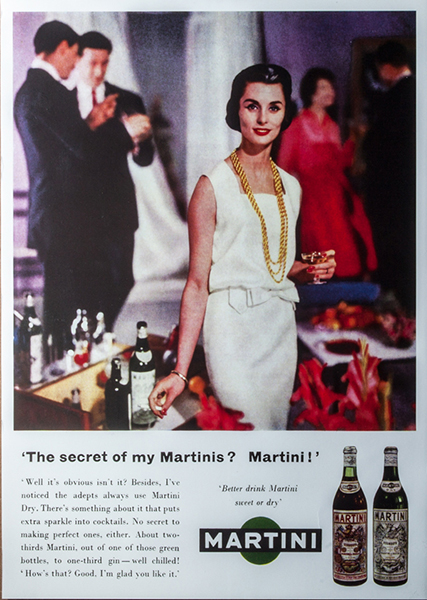
Cocktails have always seemed to be readily influenced by popular culture, and many have been named after quirky characters such as the Tom Collins, the Margarita, and the Piña Colada, which surged in popularity after the 1979 pop song ‘Escape’.
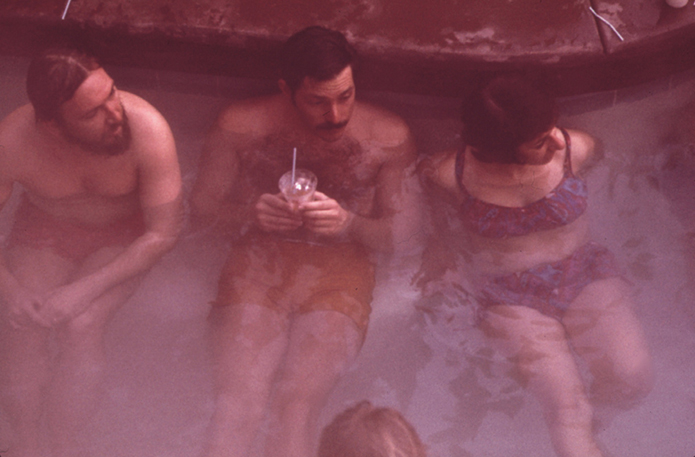
Members of the Ski Club of Washington, D.C., soak out muscle fatigue at the Continental Inn pool. Image courtesy of US National Archives, Still Picture Records Section.
Vodka often substituted the original gin in drinks, such as the martini, during the indulgent days of the YUPpies, although gin and the traditional cocktails began to make a comeback through the Nineties, which gathered momentum through the Noughties – the Cosmopolitan was boosted by the TV series Sex and the City – and into the present day, as nostalgia and authenticity, especially when it comes to food and drink, has become important once more.
And who can resist the old school glamour of a cocktail shaker, measuring jigger and stylish martini glass? These iconic cocktail accessories elevate the hum-drum and everyday into glamour and escapism, even though you are still in your kitchen… You’re James Bond casing the joint whilst nonchalantly leaning on the bar (the breakfast bar), sipping a Martini – shaken not stirred. You’re Carrie provocatively twirling your Manolo’s (slippers) at a stranger (your husband), sipping a Cosmopolitan, whilst reading Cosmopolitan…

